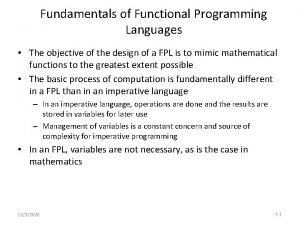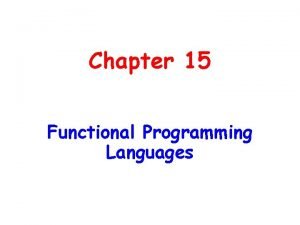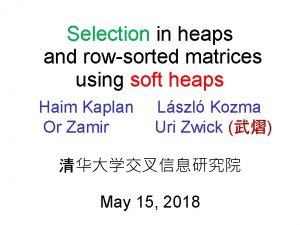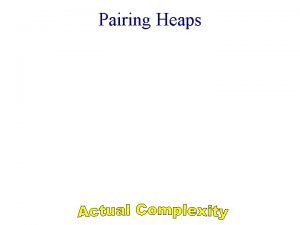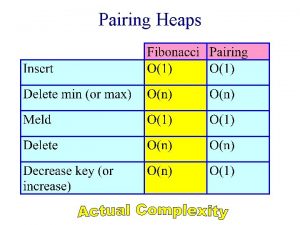Computer Science 112 Fundamentals of Programming II Heaps












![The pop Method def pop(self): self. _size -= 1 top. Item = self. _heap[0] The pop Method def pop(self): self. _size -= 1 top. Item = self. _heap[0]](https://slidetodoc.com/presentation_image/1951afc96a4b0865d25d54952b32e5cf/image-13.jpg)






- Slides: 19

Computer Science 112 Fundamentals of Programming II Heaps

Complete Binary Tree A binary tree is complete if each of its levels, with the possible exception of the last level, has a complete complement of nodes

Array Representation A complete binary tree lends itself to an array representation

Primary Use: Heaps • A heap is a complete binary tree in which items are generally less than those one level below and greater than those one level above • A heap provides logarithmic access to items that are in a natural order • Heaps are used to implement priority queues and the O(nlogn) heap sort

Examples 3 4 6 2 7 8 3 5 4 6 7 8

The Heap Interface heap. is. Empty() heap. add(item) heap. pop() heap. peek() item in heap len(heap) str(tree) iter(heap)

Using a Heap heap = Array. Heap() heap. add("D") heap. add("B") heap. add("A") heap. add("C") heap. add("F") heap. add("E") heap. add("G") print(heap) print("F" in heap) for item in heap: print(item, end = " ") while not heap. is. Empty(): print(heap. pop()) ||G |B ||E A ||F |C ||D True A B C D E F G

Using a Heap heap = Array. Heap(range(1, 8)) print("nn. Heap with 1. . 7: ") print(heap) print("for loop: ") for item in heap: print(item, end=" ") Heap with 1. . 7: ||7 |3 ||6 1 ||5 |2 ||4 for loop: 1 2 3 4 5 6 7

The Array. Heap Class class Array. Heap(Abstract. Collection): def __init__(self, source. Collection = None): self. _heap = list() Abstract. Collection. __init__(self, source. Collection) # Heap methods go here

Adding an Item to a Heap • Insert the new item at the bottom of the heap (the position after the current last item in the array) • Walk the new item up the heap, swapping it with the current parent, until the current parent is less than the new item

The add Method class Array. Heap(Abstract. Collection): def __init__(self, source. Collection = None): self. _heap = list() Abstract. Collection. __init__(self, source. Collection) def add(self, item): self. _size += 1 self. _heap. append(item) cur. Pos = len(self. _heap) - 1 while cur. Pos > 0: parent = (cur. Pos - 1) // 2 parent. Item = self. _heap[parent] if parent. Item <= item: break else: self. _heap[cur. Pos] = self. _heap[parent] = item cur. Pos = parent

Popping an Item from a Heap • Removes and returns the root item • Replace the first item with the one at the bottom (last in the array) • Walk that item down the heap until it reaches its proper place
![The pop Method def popself self size 1 top Item self heap0 The pop Method def pop(self): self. _size -= 1 top. Item = self. _heap[0]](https://slidetodoc.com/presentation_image/1951afc96a4b0865d25d54952b32e5cf/image-13.jpg)
The pop Method def pop(self): self. _size -= 1 top. Item = self. _heap[0] bottom. Item = self. _heap. pop( len(self. _heap) - 1) if len(self. _heap) == 0: return bottom. Item self. _heap[0] = bottom. Item last. Index = len(self. _heap) - 1 cur. Pos = 0 while True: left. Child = 2 * cur. Pos + 1 right. Child = 2 * cur. Pos + 2 if left. Child > last. Index: break if right. Child > last. Index: max. Child = left. Child; else: left. Item = self. _heap[left. Child] right. Item = self. _heap[right. Child] if left. Item < right. Item: max. Child = left. Child else: max. Child = right. Child max. Item = self. _heap[max. Child] if bottom. Item <= max. Item: break else: self. _heap[cur. Pos] = self. _heap[max. Child] = bottom. Item cur. Pos = max. Child return top. Item

Runtime Complexity Analysis • Insertion divides position by 2 each time items are swapped: logarithmic in worst case • Removal multiplies position by 2 each time items are swapped: logarithmic in worst case

Heap Sort • Copy the elements in the list to a heap • For each position in the list, pop an element from the heap and assign it to that position

Heap Sort Implementation from heap import Array. Heap def heap. Sort(lyst): heap = Array. Heap(lyst) for i in range(len(lyst)): lyst[i] = heap. pop()

Heap Sort Analysis from heap import Array. Heap def heap. Sort(lyst): heap = Array. Heap(lyst) for i in range(len(lyst)): lyst[i] = heap. pop() N insertions when the heap is built from the list Each insertion is O(log 2 N) N removals when the elements are transferred back to the list Each removal is O(log 2 N) Total running time (all cases): O(Nlog 2 N) Total memory: ?

A Better Version? from heap import Array. Heap def heap. Sort(lyst): heap = Array. Heap() while not lyst. is. Empty(): heap. add(lyst. pop()) while not heap. is. Empty(): lyst. add(heap. pop())

For Friday O(n) Sorting with Bucket Sort
 Nilai dari 6 sin 112 5° sin 22 5° adalah
Nilai dari 6 sin 112 5° sin 22 5° adalah Programming fundamentals 1
Programming fundamentals 1 Vallath nandakumar
Vallath nandakumar Python programming an introduction to computer science
Python programming an introduction to computer science Fundamentals of functional programming language
Fundamentals of functional programming language Ivle nus
Ivle nus Fundamentals of functional programming language
Fundamentals of functional programming language Cs 1101 programming fundamentals final exam
Cs 1101 programming fundamentals final exam Cs 1101 programming fundamentals final exam
Cs 1101 programming fundamentals final exam Cs 1101 programming fundamentals
Cs 1101 programming fundamentals Cs 1101 programming fundamentals
Cs 1101 programming fundamentals What is your favorite subject what subject
What is your favorite subject what subject Love heaps
Love heaps Lazy binomial queue
Lazy binomial queue Skew heaps
Skew heaps Mean ?
Mean ? Heaps x united style
Heaps x united style Heaps cs
Heaps cs Tom heaps
Tom heaps Soft heaps of kaplan and zwick uses
Soft heaps of kaplan and zwick uses




